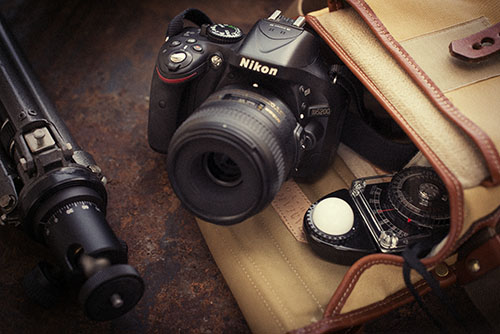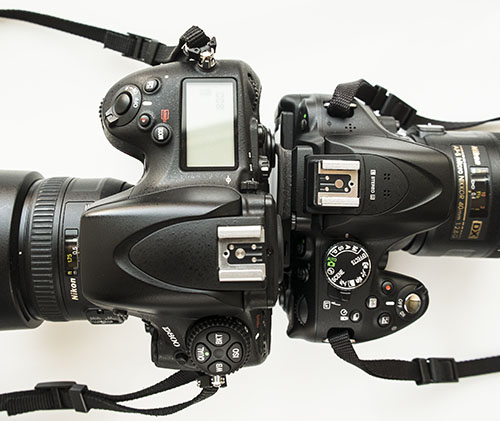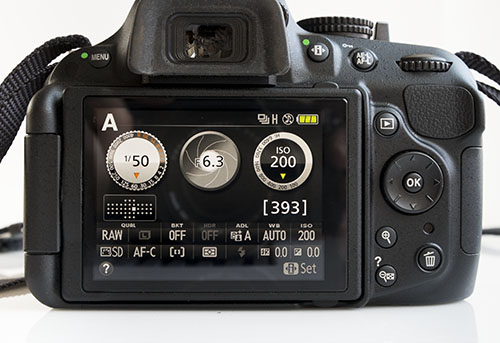Nikon D5200 camera
a hands on review
Nikon's two highest megapixel DX cameras are the D7100 and D5200. Both have a 24mp sensor. What came as a surprise is a recent sensor review on the
DxOMark website that rated the D5200 higher than the D7100 -- admittedly only by a point, but higher nonetheless. It is currently the highest rated APS-sized camera and actually rates higher than all Canon pro cameras, including the full frame models. This peaked my interest enough to make me take a look at this consumer camera to see whether it lives up to the hype.
Unlike the D7100, which is considered a semi-pro camera, the D5200 is smaller, with a body frame built mostly of plastic. Like all Nikon consumer cameras, it can only autofocus with the more modern Nikon lenses. Nikon's pro line of cameras are built of rugged, weather sealed metal bodies, and can accept almost every Nikon lens ever made. Of course, the D5200 camera body costs under $800, which is a far cry from the price of Nikon pro bodies. So the end result is pro results for a less than pro price tag.
 |
| The Nikon D5200 shown here mounted with a Nikon 40mm macro lens. |
A lot of what makes a digital camera deliver professional results is also determined by the optics you choose to put on it. For the purposes of these tests I used better quality Nikon glass rather than the kit lenses usually sold with consumer cameras. The reason I did this is because I am doing my review from the point of view of a professional photographer who might want to use a camera like this as a spare, as a "crash" camera, or as a very light weight occasional camera.
One convenient feature of the D5200 that is not even found on professional Nikon bodies is the flip out viewing screen.This makes the camera handy for reaching into tight shooting spots, overhead shots, or ground level setups.
 |
| A ground level shot like this is easy to achieve using a flip out screen while the camera is resting on the ground. |
The focusing screen has 39 focus points, 9 of them cross-type, that cover a very large part of the overall frame making it very easy to find a point to place on the subject. The viewfinder shows approximately a 95% coverage.
The frame rate on the D5200 has been raised to 5fps as opposed to the 4fps on its predecessor.
Like the D3200 and D600, the D5200 supports the WU-1a wireless remote plug-in so the camera can be controlled from a smart phone, or tablet, or upload to social media.
As already mentioned, the D5200, like other Nikon consumer cameras, cannot autofocus with all Nikon lenses. Autofocus is limited to AF-S and AF-I versions of G and D lenses.
The camera is very small, (5.9"W x 3.9"H x 3.1"D (129x128x78cm) and weighs only 1.11 lb (505g). This diminutive size makes it very convenient as a casual carry around camera for a pro -- or anybody else for that matter.
 |
| In this photo you can see how much small the D5200 is in comparison to an FX Nikon D800 on the left. |
A very practical information screen on the viewfinder makes up for the lack of many manual control buttons and wheels. The display is intuitive, and easily adjusted by highlighting any of the display items and changing it.
 |
| A graphic information screen also acts as a means of making menu selections. Push a button and the display across the bottom becomes interactive allowing you to change any of the displayed items. |
Of course a camera is only as good as the resolution quality it can deliver. Let's take a look at how well it performs.
The still life scene below was intentionally set up to mimic a tough lighting environment for high ISO shooting. The scene is lit from above with available room lights casting harsh shadows. These shadows are the telltale place for analyzing noise at high ISO's. Below each photo is a link you can use to download the full resolution image. All photos were taken in RAW but no post-processing was added. The ISO range goes from 100 to 6400 in one stop increments. ISO 1250 and 2000 were added in because they are in the more practical upper range where modern cameras tend to peak out as "acceptable" in terms of ease of fixing in post processing.
I found very little noise correction to be necessary up to the ISO 1250 and 1600 range. After that, noise reduction software was necessary but had a very easy time of producing an acceptable image, even as high as ISO 6400. Of course, excessive noise is also a product of how much you intend to enlarge the image. For most practical uses, where you might be down-sizing it, noise is very low and not visually intrusive, and even ISO 6400 would make a fine 8x10" print.
Below is a version of the above scene after it went through post-processing. Click below it to download a high res version. I think you can see that the results from this "consumer" camera compare very well with what can be achieved by top professional models.
The kit lens for the D5200 is a Nikon 18-55mm f/3.5-5.6G. While not on a par with Nikon's pro and semi-pro lenses, it is nonetheless conveniently sized and adequate for casual usage. I like having one of these lenses around for times when I just want a portable camera for things like family events. As mentioned previously, image quality is mostly a product of how large you intend to use the photograph.
The images above demonstrate how the camera performs in the worst of circumstances. Opening up the deep shadow would reveal extensive noise, which is to be expected in a situation like this. The following examples were taken under more ideal lighting conditions.
 |
| The new version of Nikon 80-400mm lens becomes the equivalent of 120-600mm, and makes a perfect combo for wildlife photography. |
Conclusion:
It's small; it's light weight; it has a plastic body -- all typical qualities of a consumer camera. Inside, however, it has a sensor and features that perform like a pro. All the features that make the D5200 a consumer camera also make it a perfect choice for professional use in tight quarters, mounted to a helicopter drone, or attached to a moving vehicle to record video.
In terms of resolution, color accuracy, dynamic range, or low light shooting the D5200 performs up there with the best of them yielding professional results that out-class many top professional cameras. The D5200 is a top flight camera at the right price. What's there not to like?
























I am a retired teacher who took up a second career as a wildlife photographer. As such, my equipment is modest. I used a D5000 until recently and have been using the D5200. I love the quality of photographs it makes, very sharp with great dynamic range. The only caveat is that with many of my photos being in demanding light situations I usually can not push the ISO as much as you describe. ISO 800 is the top of my comfort zone, with an occasional foray into 1250 territory when forced to. Noise is pretty low up to 800 but I have to work at cleaning up some of the 1250 shots. All in all I highly recommend this camera. It is a joy to use and gives remarkable photos, much better than my old D5000.
ReplyDelete